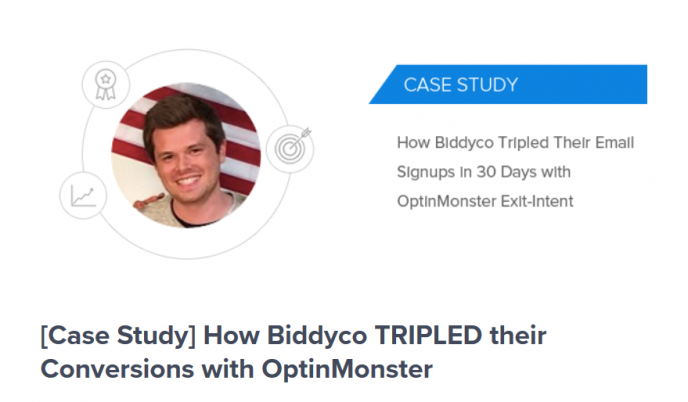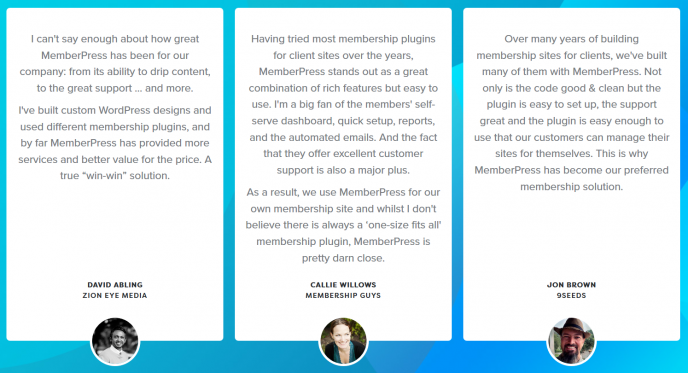Building trust for your business is difficult. But, don’t worry. You can increase trust with customer testimonials. Testimonials prove to consumers that your business has happy, satisfied customers.
Instead of telling shoppers your business is great, your customers can speak for you, which is more effective in building trust. In fact, according to statistics, customer testimonials are the most effective form of content, coming in at an 89% effectiveness rating, compared to other content types. So, you’ll want to take advantage of customer testimonials and use them in a variety of ways to increase trust and boost conversions.
Here are 7 ways to use customer testimonials in your content.
1. Add Testimonials to Your Homepage
Many times, the homepage is the first page on your website that users will see. By adding customer testimonials to your homepage, you can make a great first impression on first-time visitors.
Here’s how MemberPress displays customer testimonials on their homepage:
In the middle of their homepage, they display 3 testimonials from their happy customers that describe how they used MemberPress to reach their goals. They also include photos of the customers. Adding photos to your customer testimonials is a great way to grab the attention of website visitors and show that the testimonials come from real people.
2. Add Them Next to CTAs
Don’t stop at just the homepage. You can add customer testimonials to many different places on your website by adding them next to CTAs (call-to-actions). For example, you can add a customer testimonial next to the CTA on your pricing page or product page.
A user that visits your website isn’t always ready to buy, they may still be thinking about it and looking for information that tells them they can trust your business. But customer testimonials act as a form of social proof. So, when a user sees a customer testimonial on your product page, it encourages them to buy the product for themselves. Adding testimonials near your CTAs is an effective way to drive conversions. In fact, according to social proof statistics, testimonials can increase conversion rates on sales pages by 34%.
3. Incorporate Testimonials into Blog Content
Sometimes, users will land on your website by chance after discovering one of your blog posts online. This is a good opportunity to get that user interested in what your business has to offer by incorporating testimonials into your blog content.
But, instead of adding testimonial quotes into the body of your blog post and distracting readers, add them to the sidebar instead. With a WordPress plugin like Testimonial Rotator, you can easily add rotating testimonials to the sidebar of your posts or pages.
4. Create a Customer Testimonial Page
You can also put all of your glowing customer testimonials into one place by creating a customer testimonial page on your site. A customer testimonial page can give website visitors more details about the results your customers have gotten from your product or service.
For example, BioClarity has a dedicated page on their site to display testimonials, called “Proven Results.” On this customer testimonial page, they include before and after photos, quotes from satisfied customers, and video testimonials.
5. Use Them in Email Marketing Campaigns
Email marketing is one of the most effective strategies for turning leads into customers. So, be sure to add customer testimonials to your email marketing campaigns.
There are a number of ways you can use customer testimonials in your email marketing campaigns, including:
- Adding short product reviews
- Sending video testimonials
- Sharing user-generated content
- Telling customer success stories
But, don’t throw customer testimonials into your emails without a rhyme or a reason. Make sure they’re relevant to the content of the email and personalized to the subscriber. For example, if a subscriber has previously browsed men’s suits on your website, you can send them an email that features your online store’s top-rated suits along with customer reviews for them.
6. Share Testimonials on Social Media
You can also share customer testimonials with your followers on social media. Testimonials are typically short quotes, so they’re perfect for sharing on social media platforms like Facebook, Instagram, and Twitter.
Here’s how Jimdo shares customer testimonials on social media. On the company’s Instagram page, they share an eye-catching image with a testimonial quote on top of it to grab the attention of users. Then, they add the full testimonial to the caption.
You can easily create images to share your testimonials on social media using a free tool like Adobe Spark or Canva.
7. Create Case Studies
Take customer testimonials a step further by turning them into case studies. A case study goes more in-depth than a customer testimonial because it shares the full customer story, including why they needed your product/service, how it helped them reach their goals, and what results they got.
At OptinMonster, we regularly create case studies that show how our customers use OptinMonster to grow their email lists, generate leads, and increase conversions. Here’s an example of an OptinMonster case study:

To create a case study, all you need to do is interview a happy customer or send them a survey. With the answers they provide, you can then write a case study and post it on your company blog.
Over to You
That’s it! With these tips, you can make the most out of your customer testimonials. Get ready to turn the words of your happy customers into more sales for your business.
Syed Balkhi is an award-winning entrepreneur and online marketing expert. He is the co-founder of OptinMonster, WPBeginner, MonsterInsights, and WPForms.


